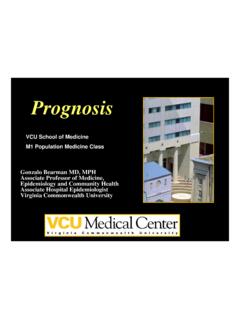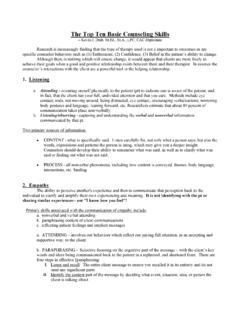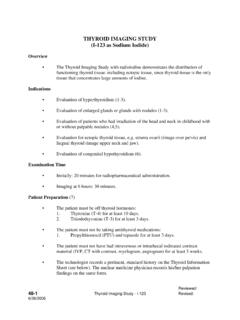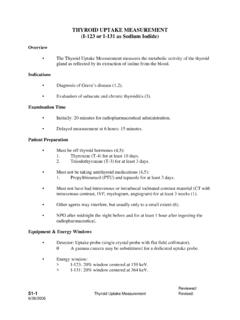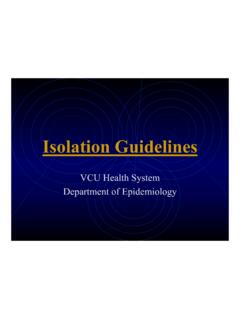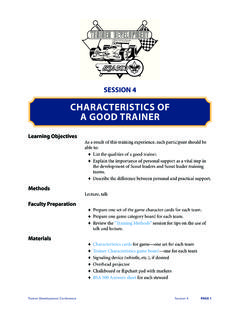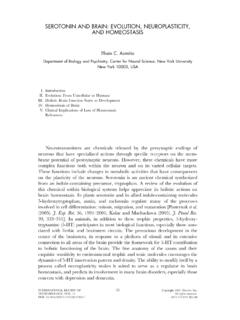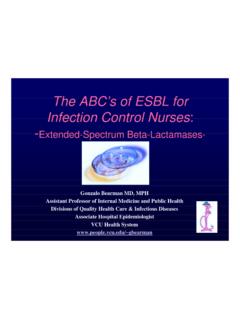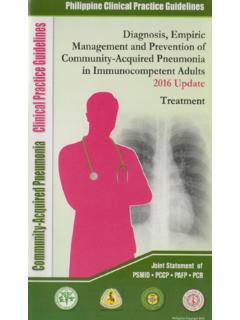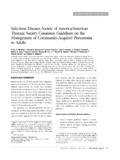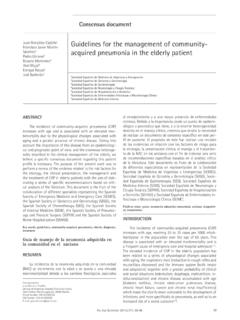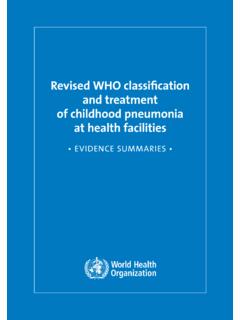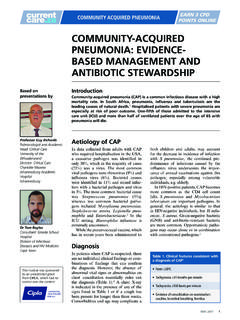Transcription of Community Acquired Pneumonia: for Medical Residents
1 Community Acquired pneumonia : for Medical ResidentsGonzalo Bearman MD, MPHA ssistant Professor of Internal Medicine and Public Health Divisions of Quality Health Care & Infectious DiseasesAssociate Hospital EpidemiologistVCU Health SystemOutline Scope of the problem Epidemiology Clinical Presentation Bacteriology and pathophysiology Typical vsatypical pathogens Therapy Inpatient vsOutpatient pneumonia Severity Index Therapy Outpatient, inpatient, ICU Selected diagnostic tests ConclusionScope of the problem Epidemiology: Sixth leading cause of death number one cause of death from infectious disease Up to million cases per year >10 million physician visits million hospitalizations Average rate of mortality for hospitalized patients 12%NiedermanNiedermanMS, et al. MS, et al. Am J Am J RespirRespirCritCritCare MedCare Med.
2 2001;163:1730. 2001;163 Clinical PresentationCase 1A 19-year-old college student presents with fever, cough, and sore throat of 4-week duration. The student health service prescribed erythromycin, and she took the antibiotic faithfully despite nausea and diarrhea, but the low-grade fevers and nonproductive cough persisted. One week after the onset of illness, persistent hoarseness developed. The patient deniesheadaches, abdominal pain, weight loss, and night sweats, and she has no known allergies. Her past Medical history includes an , B. Infectious Diseases , Infectious Disease Pearls, Examination: Temperature ; pulse 78; respirations 22; blood pressure 120/60. General: wellappearing, but coughing. HEENT: some pharyngeal edema, otherwise normal. Chest: minimal right lower lobe rales.
3 Cardiac: normal. Abdomen: soft, nontender, no organomegaly. Laboratory Findings: WBC 8900/ l; ESR 32 mm/hr. Liver function tests: normal. BUN and creatinine: unremarkable. Urinalysis: 1+protein. Cold aggultinin 1:4. Electrocardiogram: normal. Cunha, B. Infectious Diseases Pearls. 1999 Chest X-rayWhat is your presumptive diagnosis?Case 2A 70-year-old man presents to the emergency department complaining of right-sided pleuriticchest pain, cough productive of thick greenish-yellow sputum, increasing dyspnea, fevers, and shaking chills-all of 2-day duration. He denies nausea, vomiting, and diarrhea. His past Medical history is significant for chronic obstructive pulmonary disease (COPD), tracheostomyfor laryngeal cancer, and alcohol , B. Infectious Diseases Pearls.
4 1999 Cunha, B. Infectious Disease Pearls. 1998: 145 Physical Examination: Temperature ; respirations 26;heart rate 110; blood pressure 140/84. General: ill appearing, but alert and orientated to person, place and time. HEENT: thick, greenish-yellow sputum from tracheostomy tube. Chest: bilateral scattered rhonchiand bronchial breath sounds, with dullness to percussion and egophonyat the right base. Laboratory Findings: ; WBC 15,800/ l with 88% polymorphonuclearcells, 8% bands, 4% lymphocytes. Na+137 mEq/L. BUN 32 mg/dl, mg/dl. Arterial blood gas (room air): pH , PCO2 78 mmHg. Sputum Gram stain:abundant leukocytes and gram-positive diplococci. Blood cultures: , B. Infectious Diseases Pearls, X-rayWhat is your presumptive diagnosis?PathophysiologyPathogeneticMec hanisms in PneumoniaCopyright 2002 The Cleveland Clinic FoundationMore common in immunocompromisedhostsReactivation Less commonDirect inoculation Rare Invasion from infection in contiguous structuresUncommonHematogenousdeposition CommonAspiration of oropharyngealor gastric contentsCommon Inhalation of infectious particlesFrequencyMechanism pneumoniae1-6%Mycoplasmapneumoniae2-8%Le gionellaspecies3-10%Gram-negative bacilli3-5%Staphylococcus aureus3-10%Haemophilusinfluenzae20-60%St reptococcus pneumoniaePercentageof CasesPathogenIdentified Pathogens inCommunity- Acquired .
5 Inpatient vsOutpatientPneumonia Severity IndexPneumonia Severity IndexAntibiotic ChoiceIDSA CAP GuidelinesInitial Antibiotic Selection-OutpatientAmoxicillin-clavulan ate or clindamycinA -lactam or a respiratory fluoroquinoloneSuspected aspiration with infectionInfluenza with bacterial superinfectionA macrolide or doxycyclineA respiratory fluoroquinolone alone, an advanced macrolide plus high-dose amoxicillin, or an advanced macrolide plus high-dose advanced macrolide of a respiratory fluoroquinoloneA respiratory fluoroquinolone alone or an advanced macrolide plus a -lactamPreviously healthyNo recent antibiotic therapyRecent antibiotic therapyComorbidities(COPD, diabetes, renal or congestive heart failure, or malignancy)No recent antibiotic therapyRecent antibiotic therapyAppropriateness of antibiotic Appropriate selection of initial antibiotic therapy Streptococcus pneumoniaecauses two-thirds of all cases of bacteremicpneumonia Need to cover potentially resistant strains of S.
6 Pneumoniaeand atypical organisms for patients admitted to ICUT iming and Choice of AntibioticsAntibiotic Timing at 4 hours cutoff: IDSA B-III Antibiotic Choice of Therapy: IDSA A-I ICU Pseudomonal Risk* -lactam (IV or IM) + macrolide (IV or Oral) or -lactam (IV or IM) + doxycycline (IV or Oral) or Quinolone monotherapy (IV or Oral) -lactam (IV) + macrolide (IV) or -lactam (IV) + quinolone (IV) If documented -lactam allergy: Quinolone (IV) + Clindamycin (IV) or Quinolone (IV) + Vancomycin (IV) *In addition to the antibiotics listed under ICU, if the patient had a secondary ICD-9 code of bronchiectasis, or a positive response to the bronchiectasis question, or malnutrition [as reflected by a serum albumin below 3], these antibiotics would also be considered acceptable: Antipseudomonal -lactam (IV) + Antipseudomonal quinolone (IV) Or Antipseudomonal -lactam (IV) + Aminoglycoside (IV) + either a [Macrolide (IV) or Antipneumococcal quinolone (IV)] If documented -lactam allergy:Aztreonam (IV) + Aminoglycoside (IV) + Antipneumococcal quinolone (IV) Initial Antibiotic Selection-inpatientAdapted from IDSA: Update ofPractice Guidelines for the management of Community Acquired pneumonia in Adults.
7 CID 2003;37:1405-1432 Adapted from IDSA: Update ofPractice Guidelines for the management of Community Acquired pneumonia in Adults. CID 2003;37:1405-1432 Initial Antibiotic Selection30-day mortality - Community -dwelling Patients (14,150 patients) (. ) (. ) (. ) ( ) (. ) (. ) (. )277/3072 ( )19/431 ( )73/844 ( )121/1716 ( )80/445 ( )231/3618 ( )63/723 ( )17/158 ( )3rdgeneration cephalosporin*Macrolide monotherapy 2ndgeneration cephalosporinQuinolone monotherapy At least 1 aminoglycosideCephalosporin + macrolide Cephalosporin + quinolone -lactam/ -lactamase inhibitor + macrolide P ValueAdjusted Odds Ratio aOR (95% CI)30-day mortalityN/D (%)Initial Antibiotics*monotherapy with cefotaxime or ceftriaxone. Results adjusted for age, gender, neoplastic disease, cardiovascular disease, altered mental status, respiratory rate >30/min, systolic BP < 90 mmHg, temperature < 35C or >40C, pulse >125/min, blood pH < , BUN > mmol/L, sodium < 130 mEq/L, hematocrit < 30%, pO2 < 60 mmHg, pleural effusion, admission to ICU in the first 24 hours after arrival, antibiotics administered within the first 4 hours after arrival, and US census region.
8 These antibiotic combinations include patients receiving either oral or parenteral macrolides or DW. Houck PM, et al. [abstract] American Thoracic Society, Causing CAP in Hospitalized Patients Requiring ICU Admission Overall up to 10% of admitted patients with CAP are brought to the ICU 30% caused by Streptococcus pneumoniae 50-60% have an unknown etiology Other reported organisms Legionella (underlying bronchiectasis) Enterobacteriacae(underlying bronchiectasis)American Thoracic Society 2001. Am J RespirCritCare Definition Severe CAP and Need for ICU Admission [1] Combination of 2 minor or 1 major criteria (retrospective analysis-sensitivity of 78% and Specificity of 94%) [2] Minor: RR>30/minute PaO2/FiO2 ratio <250 Bilateral or multilobarpneumonia Systolic BP<90 mmHg and diastolic BP<60 mmHg Major Need for mechanical ventilation Increase in the size of infiltrates by 50% within 48hr Septic shock or the need for pressors Acute renal failure1.
9 American Thoracic Society 2001. Am J RespirCritCare Ewiget al. Am J RespirCritCare Med1998 of antibiotics Bratzleret al; Archives of Internal Medicine2004. In press Retrospective study 13,771 patient from a random Medicare registry sample CAP; Age >65; 7/1998-3/1999 Outcome Measures Antibiotic administration within 4 hours Mortality (severity-adjusted) Readmission within 30 days Length of stay (LOS)Association between Antibiotic First Dose Timing and (. ) (. ) (. ) (. )Adjusted Odds RatioaOR (95% CI) mortalityIn-hospital mortalityLength of stay > 5 days30-day readmissionAfter 4 hours%Within 4 hours%OutcomeUsing multivariate logistic regression [the model included the timing of antibiotic first dose, PSI score, ICU admission, US census region, race/ethnicity, other processes of care (oxygenation assessment, performance of blood cultures, and antibiotic selection)].
10 Houck PM, Bratzler DW, Nsa W, Ma A, Bartlett JG. Arch Intern Med. 2003 (In Press).Early (within 4 hours) administration of antibiotics associated with decreased mortality and shorter LOSE arly (within 4 hours) administration of antibiotics associated with decreased mortality and shorter LOSF irst Dose Timing and (. ) (. ) (. ) (. ) (. ) (. ) (. ) (. ) (. ) (. )Adjusted Odds RatioaOR (95% CI) <1 hour vs > 1 hour<2 hours vs > 2 hours<3 hours vs > 3 hours<4 hours vs > 4 hours<5 hours vs > 5 hours<6 hours vs > 6 hours<7 hours vs > 7 hours<8 hours vs > 8 hours<9 hours vs > 9 hours<10 hours vs > 10 hoursGroup 2 Mortality%Group 1 Mortality%Timing of First DoseGroup 1 vs Group 2 Retrospective analysis: early antibiotic treatment associated with decreased odds of mortalityRetrospective analysis: early antibiotic treatment associated with decreased odds of mortalityUsing multivariate logistic regression [the model included the timing of antibiotic first dose, PSI score, ICU admission, US census region, race/ethnicity, other processes of care (oxygenation assessment, performance of blood cultures, and antibiotic selection)].
